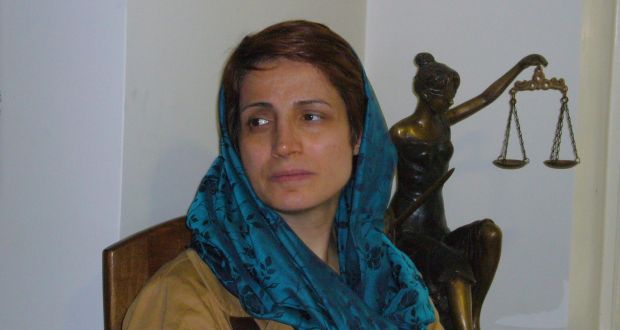
Inspiring women – An Irishwoman’s Diary on International Women’s Day
By: Lara Marlowe
It is vital for girls and young women to have role models
I was 10 years old when my teenage brother defied me to “name one famous woman writer or artist”. I wept angry tears, and began drawing up a mental list of inspiring women.
I felt a burst of pride last July, when I learned that Ursula von der Leyen had been appointed to the presidency of the European Commission, and Christine Lagarde to lead the European Central Bank.
In decades as a journalist, I have met many inspiring women. Nasrin Sotoudeh, a frail, petite human rights lawyer who I interviewed in Tehran in 2014, is one of the most impressive people I have ever met.
Like Mahatma Gandhi, she advocates non-violent civil disobedience. Like Nelson Mandela, she has paid for her struggle with years in prison.
When I interviewed her, Sotoudeh had recently served three years in Tehran’s infamous Evin prison, for defending participants in the 2009 Green Revolution against then-president Mahmoud Ahmadinejad.
Sotoudeh was arrested a second time in June 2018, for signing a petition demanding a referendum on whether Iran should remain an Islamic Republic, and various alleged security offences. She was sentenced to a total of 38 years in prison and 148 lashes with the whip.
The Facebook page of Sotoudeh’s devoted husband, Reza Khandan, is the conduit for news about her. Khandan says that only the most severe of several sentences will be carried out, meaning Sotoudeh is likely to spend the next 10 years in prison for “encouraging corruption and debauchery”. Her real sin was to defend women who tore off their headscarves in 2018 protests.
The European Parliament gave Sotoudeh its Sakharov Prize for free speech in 2012, and protested to the Iranian government when she was rearrested. Amnesty International is campaigning for her release.
Long before I met Sotoudeh, I particularly admired two women born in the 19th century, the painter Berthe Morisot, who was a founding member of the Impressionist movement, and the novelist Edith Wharton, the first American woman to win the Pulitzer Prize for literature.
Morisot and her sister Edma wanted to be painters. The fine arts academy was closed to women, so their parents hired private tutors. The sisters were so talented that they risked becoming professional painters, their teacher, Joseph Guichard, warned the Morisot parents: “Do you realise what that means? In your upper middle class milieu, it will be . . . almost a catastrophe. Are you sure you will not one day curse me?”
To Berthe’s chagrin, Edma stopped painting when she married a naval officer. Morisot so doubted her own ability that she destroyed her early works. She formed a life-long friendship with Edouard Manet, though he enraged her by re-working one of her paintings.
Morisot married Edouard Manet’s brother Eugène, who supported her unconditionally. Manet and Puvis de Chavannes, also a painter, strongly urged Morisot not to join the renegade artists who organised the first Impressionist exhibition in 1874. She ignored them, and braved virulent criticism. Renoir recounted that a visitor to the exhibition called her a prostitute. Pissarro punched him in the face, and police had to break up the ensuing brawl.
Edith Newbold Jones was born 21 years after Morisot, in Manhattan, where her family had amassed a fortune in property. The expression “keeping up with the Jones” is believed to have originated with them. She later married Edward Robbins Wharton, from a wealthy Boston family. It was an unhappy marriage, and they eventually divorced. Like Morisot, Wharton was expected to be decorative and catch a good husband. Like Morisot, she thirsted for education and rebelled against convention.
Her early works were published anonymously, because her family did not want their name to appear in print.
Commercial success came in 1905, with publication of The House of Mirth, which Wharton described as about “wasted human possibilities” and “a society so relentlessly materialistic and self-serving that it casually destroys what is most beautiful and blameless within it”.
Wharton’s novels are about the internal conflict between duty and self-fulfilment, the theme of The Age of Innocence, which won the Pulitzer Prize in 1921. The perfect engagement of Newland Archer, a young New York lawyer, is troubled when he falls in love with his fiancée’s cousin, Countess Ellen Olenska.
Wharton lived much of her adult life in the rue de Varenne in Paris, around the corner from my home. Her characters have become part of my life. I think of Newland Archer gazing up at Countess Olenska’s windows when I pass a certain building near Les Invalides. The French government gave Wharton the Legion of Honour for fundraising and volunteer work for refugees during the first World War. She travelled to the frontlines and reported for Scribner’s Magazine and the New York Times.
These extraordinary women taught me invaluable lessons. I profoundly admire Sotoudeh’s determination and willingness to sacrifice her own well-being in the cause of justice. I love the beauty that Morisot created, and her wish to, as she put it, “freeze something of the passage of time.” I am awed by Wharton’s powers of observation, curiosity and ability to find the mot juste.
Women cannot believe in themselves if parents, teachers, employers and even voters – as shown in the recent Irish election – do not. It is important for girls and young women to have role models, because self-confidence comes less easily to us. If International Women’s Day serves no other purpose, let us examine our own unconscious bias, and celebrate inspiring women.
Source: Irish Times



